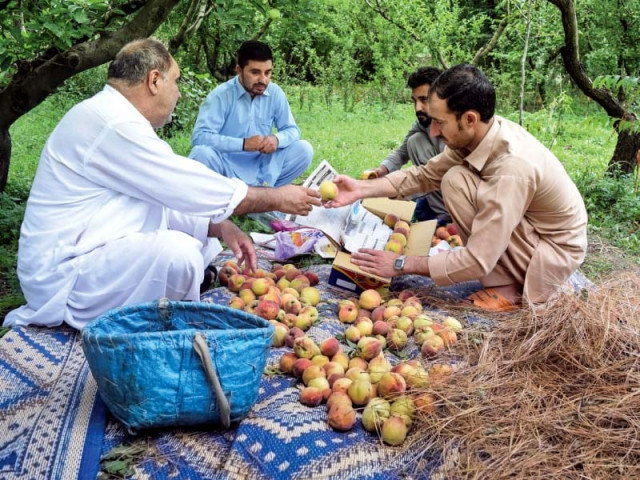Swat's variety of peaches exported, appreciated across the world
Since competition is stiff farmers battle to produce finest fruits

Men pack peaches into boxes at farm in Mingora, Swat. PHOTO: EXPRESS
Historically, the valley is billed as one of the cradles of ancient civilisation. In a world that has changed tremendously through advancements in science and technology, farmers still use traditional methods and tools to make the most of the valley’s fertile soil.
Take your pick
Swat produces apples of 20 different kinds and 18 varieties of peaches, which are exported and appreciated across the world.
Sweet talk: Abazai’s mangoes offer heavenly treat
Ihsanullah, a peach grower and farming expert, tells The Express Tribune he can recall the varieties of peaches grown in Swat on his fingertips.
“The first kind of peach starts growing in May,” he explains. “May 25 is the date when Jaitay becomes available in the market.”
Ihsanullah adds the second kind of peach is locally named Ali Green and it hits the markets in the first week of June. Comparing the two, the farmer points out the second kind of peach, Ali Green, is preferred as it is sweeter.
Talking about the other varieties that come a little later into the season, Ihsanullah says the locally called Doyam Haray is produced in the third week of June and is also available in the market. The fourth form of peach is Soyam.
He adds the growing of Soyam and onward production mark the beginning of a difficult time in the market for peach growers.
“The farmers try to reach the market earlier with the aim of maximising sales,” he says. “Any delay can be costly and will deprive the peach growers of a healthy income.”
Ihsanullah tells The Express Tribune the fifth produce is named the Golden. However, there is another breed within this kind of peach and it is called the China Panjam.
”Both the Golden and China Panjam simultaneously reach the market and are available by the start of July,” he adds.
The sixth kind, called Shasham, is available in the second week of July.
Eid holidays: Half a million happy campers flock to Swat
”There are another three breeds within Shasham and all are different in their physical appearance, but their taste is almost identical,” he says.
Ihsanullah highlights that the seventh is called Spin Pakhay and is the most expensive, not to mention delicious, produce of the peach season. It starts production in the third week of July and is available by the last week of the same month.
“The Hashtam reaches the market in the first week of August and remains till the third week,” he adds. It marks the end of the season. However, some mountainous areas in the upper parts of Swat keep producing peaches which are available till September 15.
Ihsanullah adds the entire peach producing season is a great time for income generation. The farmer states much of their daily income is generated from the process of peach plucking and packing.
“Those plucking peaches from the trees are locally called Shokmar and their daily income is Rs500,” Ihsanullah says. “Packing is done skillfully and labourers involved in such a process earn Rs700 daily.”
Published in The Express Tribune, September 3rd, 2016.













COMMENTS
Comments are moderated and generally will be posted if they are on-topic and not abusive.
For more information, please see our Comments FAQ